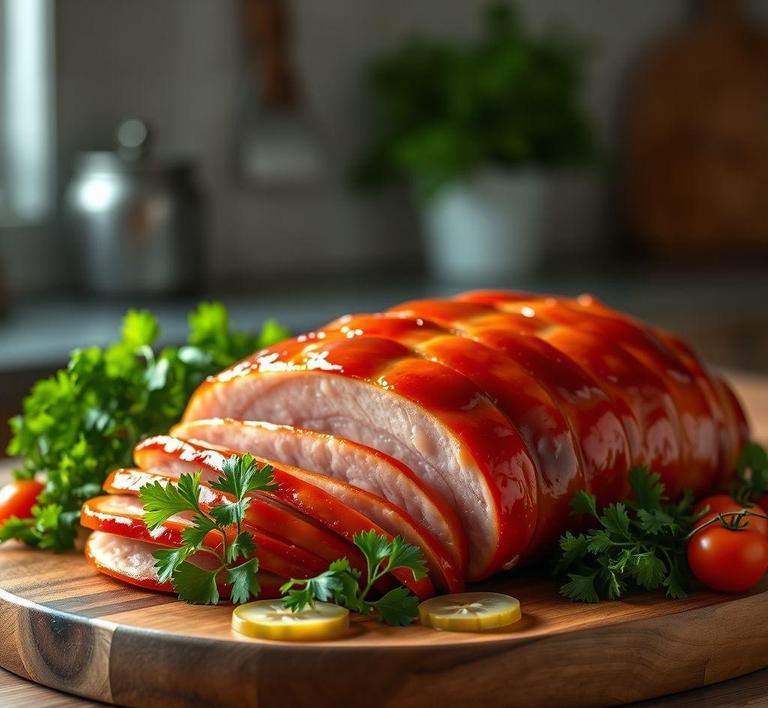If you’ve ever made a delicious ham loaf and had leftovers, you might be wondering if it’s safe to refreeze it for later. Well, the good news is, yes, you can refreeze ham loaf, but there are some important tips and tricks to keep in mind to ensure it stays tasty and safe to eat. In this guide, we’ll walk you through the best practices for freezing and refreezing ham loaf, from the right way to store it to how to thaw and reheat it so it’s just as delicious the second time around. Let’s dive in!
Can You Refreeze Ham Loaf?

The question of whether you can refreeze ham loaf is a common one, and the answer isn’t a simple yes or no-it depends heavily on how the ham loaf was handled after it was first thawed. In general, refreezing any cooked meat, including ham loaf, is safe only if it has been thawed properly and kept at a safe temperature.
Ham loaf, being a processed meat product, typically has preservatives that help it stay fresh longer, but these do not eliminate the risk of bacterial growth once the loaf is thawed. If your ham loaf was thawed in the refrigerator and kept at or below 40°F (4°C), and has not been left out at room temperature for more than two hours, you can safely refreeze it. This process limits bacterial growth, ensuring food safety.
However, if the ham loaf was thawed using a faster method-like in the microwave or cold water-or if it has been sitting out for a prolonged time, refreezing is not recommended. This is because partial thawing followed by refreezing can allow bacteria to multiply during the thawed period, increasing the risk of foodborne illness.
In summary, yes, you can refreeze ham loaf if it has been thawed safely and kept refrigerated, but if it has been left out too long or thawed improperly, it’s best to avoid refreezing.
How To Refreeze Ham Loaf?
If you decide to refreeze ham loaf, doing it correctly is crucial for both safety and quality.
- Cool Down Quickly: Before refreezing, make sure the ham loaf has been cooled completely to refrigerator temperature after cooking or thawing. Warm or hot meat should never go directly into the freezer, as it raises the freezer’s temperature and can cause partial thawing of other foods.
- Wrap Properly: Use airtight packaging to prevent freezer burn. The best practice is to wrap the ham loaf tightly in plastic wrap or aluminum foil, then place it inside a freezer-safe ziplock bag or an airtight container. Removing as much air as possible helps preserve texture and flavor.
- Label and Date: Always mark the package with the date you are refreezing the ham loaf. This helps keep track of storage time, as the quality of frozen ham loaf is best within 1-2 months.
- Freeze Quickly: Place the ham loaf in the coldest part of your freezer to freeze it rapidly. The quicker it freezes, the smaller the ice crystals that form inside the meat, which helps retain its texture.
- Thaw Safely Next Time: When you eventually thaw the refrozen ham loaf, do so in the refrigerator or use the defrost setting on a microwave to minimize bacterial growth.
Following these steps reduces food safety risks and helps preserve the ham loaf’s taste and texture as much as possible during the refreezing cycle.
Quality Impact
Refreezing ham loaf can affect its quality in several ways, even if it remains safe to eat.
Texture Changes: The biggest impact is usually on texture. When meat freezes, the water inside its cells forms ice crystals. These crystals can rupture cell walls, leading to moisture loss once thawed. Refreezing exacerbates this effect because the meat is thawed and refrozen multiple times, causing more moisture to be lost each cycle. As a result, refrozen ham loaf may become drier and crumbly.
Flavor Alterations: Although ham loaf contains preservatives and spices, refreezing can dull its flavor. The oxidation process, even in the freezer, can degrade delicate flavors, especially if the packaging is not airtight. The ham may taste less fresh or slightly off compared to the original batch.
Appearance: Refrozen ham loaf might develop freezer burn-those dry, pale patches caused by air exposure. Freezer burn affects appearance and texture negatively but is not harmful to eat.
Nutritional Value: The nutritional impact is minimal, though slight losses in moisture and vitamins can occur with multiple freeze-thaw cycles.
In essence, while the ham loaf remains edible and safe if refrozen correctly, repeated freezing can noticeably reduce its quality in taste, texture, and appearance. For the best eating experience, try to avoid multiple freeze-thaw cycles when possible.
Refreezing ham loaf is a nuanced topic: it is safe under the right conditions but comes with compromises. If your ham loaf has been thawed properly in the refrigerator and kept cold, refreezing is permissible and won’t pose a significant health risk. However, if thawed improperly or left out too long, it’s safer not to refreeze.
To successfully refreeze, ensure the ham loaf is cooled quickly, wrapped tightly to avoid freezer burn, and frozen promptly to maintain maximum quality. Still, be aware that refreezing can degrade the ham loaf’s texture and flavor, sometimes noticeably.
Ultimately, the best approach is to portion your ham loaf into smaller servings before freezing initially, so you can thaw only what you need, reducing the need for refreezing altogether. This helps preserve the deliciousness of your ham loaf while keeping food safety front and center.
Is It Safe To Refreeze Ham Loaf?
Refreezing ham loaf, like many other prepared meats, can be safe-but only under specific conditions. The key lies in how the ham loaf was handled between thawing and the decision to refreeze.
If the ham loaf was thawed in the refrigerator and has not spent more than 2 hours at room temperature, it can generally be refrozen without posing a significant health risk. This is because the controlled cold environment of a refrigerator slows bacterial growth, preserving the loaf’s safety and integrity.
However, if the ham loaf was thawed on the counter, or if it sat out beyond the 2-hour mark (or 1 hour if the ambient temperature is above 90°F/32°C), refreezing is strongly discouraged. Bacteria such as Listeria monocytogenes or Salmonella can multiply rapidly in the danger zone of 40°F to 140°F, and once refrozen, these pathogens don’t simply disappear. While freezing halts bacterial growth, it doesn’t kill bacteria that may have already proliferated.
Moreover, consider the composition of ham loaf-it typically includes ground meat, breadcrumbs, eggs, and sometimes vegetables. This medley is particularly susceptible to microbial spoilage if not kept at the proper temperatures.
In summary: Yes, you can refreeze ham loaf-but only if it was safely thawed in the refrigerator and hasn’t lingered in the temperature danger zone.
Signs That Ham Loaf Should Not Be Refrozen
Before even thinking about popping that ham loaf back into the freezer, examine it closely. Certain signs are red flags that the dish has already begun to spoil and is no longer suitable for refreezing:
- Off-Putting Odor: Fresh ham loaf should have a mildly savory, meaty smell. If you detect sourness, a sulfur-like tang, or any kind of rancid or sour aroma, it’s time to toss it.
- Discoloration: Look for any grayish, greenish, or brown spots, especially around the edges or on the surface. These could indicate mold growth or oxidation that has progressed too far.
- Slimy or Sticky Texture: A slightly moist loaf is normal, but a sticky, gummy, or overly slick surface signals bacterial activity.
- Unusual Taste (if already reheated): If you’ve already cooked or reheated some of the loaf and the taste seems bitter, overly tangy, or just “off”, don’t chance refreezing the rest.
- Time Out of Safe Temperature Range: If the loaf has been out of refrigeration for more than 2 hours (or more than 1 hour on a hot day), it’s no longer safe to refreeze-regardless of appearance.
Common Refreezing Mistakes
Refreezing ham loaf is more nuanced than simply tossing it back into the freezer. Here are several common mistakes that people often make, each with the potential to impact food safety and quality:
- Refreezing After Microwave Thawing: Microwaves can cause uneven thawing and even partial cooking. If ham loaf has been microwaved to thaw, and parts of it are warm, bacteria may have already started growing. Never refreeze microwave-thawed food unless it was immediately cooked.
- Repeated Freeze-Thaw Cycles: Each time ham loaf is thawed and refrozen, its texture degrades. Moisture loss leads to dryness, and flavor diminishes. Constant freeze-thaw cycling is a sure way to ruin both taste and food safety.
- Not Cooling Cooked Leftovers Before Refreezing: If you’ve cooked a previously frozen ham loaf and want to refreeze the leftovers, ensure it cools completely before putting it back in the freezer. Hot food in a freezer can raise the internal temperature, partially thawing nearby items.
- Freezing in Large Portions: Freezing a whole loaf together may mean that only the outside properly freezes while the inside remains vulnerable. Instead, portion it out before freezing so it cools and freezes evenly.
- Using Improper Packaging: Wrapping a ham loaf in a single layer of foil or using thin plastic wrap can lead to freezer burn. Freezer burn affects taste and texture and makes the loaf unappetizing even if it’s technically safe to eat.
Tips and Tricks for Successfully Refreezing Ham Loaf
If you’ve determined that your ham loaf is safe to refreeze, follow these expert tips to maintain its best quality and safety:
- Divide into Portions: Slice the ham loaf into meal-sized servings. This makes it easier to thaw only what you need, minimizing future freeze-thaw cycles.
- Double-Wrap for Freshness: Use freezer-safe containers or double-wrap in plastic wrap followed by aluminum foil. Label each package with the date and contents to keep track.
- Freeze Quickly: Place the wrapped ham loaf near the back wall of the freezer where temperatures are most consistent. The faster the food freezes, the fewer ice crystals form-preserving the texture.
- Use Within 2-3 Months: Even with the best practices, refrozen ham loaf is best consumed within a couple of months. After that, quality begins to drop, and risk of freezer burn increases.
- Thaw Safely: Always thaw in the refrigerator-not on the counter-to ensure safety. If you’re in a rush, you can thaw sealed portions in a cold water bath, changing the water every 30 minutes.
Conclusion
Ham loaf can be a comforting, savory staple-perfect for family dinners or repurposed into sandwiches and breakfast hashes. While refreezing ham loaf is possible, it demands diligence. The key lies in proper thawing practices, recognizing signs of spoilage, and using airtight freezing methods.
If done correctly, refreezing won’t just salvage leftovers-it’ll save time, reduce food waste, and keep your meals flavorful and safe. But when in doubt, trust your senses and err on the side of caution. After all, no ham loaf is worth a foodborne illness.


